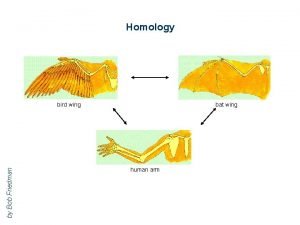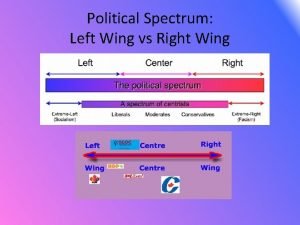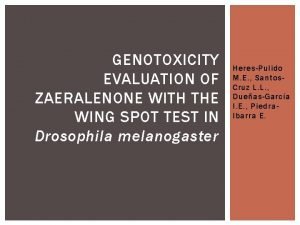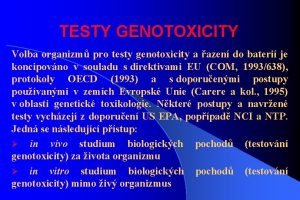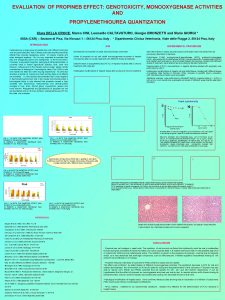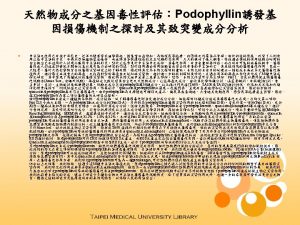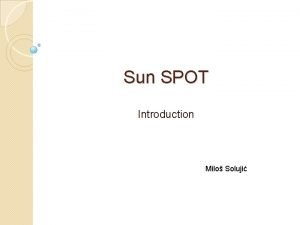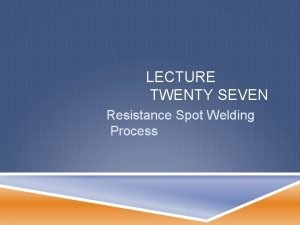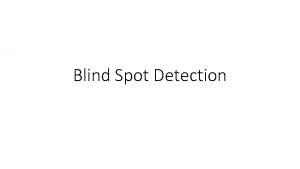GENOTOXICITY EVALUATION OF ZAERALENONE WITH THE WING SPOT





























- Slides: 29

GENOTOXICITY EVALUATION OF ZAERALENONE WITH THE WING SPOT TEST IN Drosophila melanogaster Heres-Pulido M. E. , Santos. Cruz L. L. , Dueñas-García I. E. , Piedra. Ibarra E.

ZEARALENONE ZEA is a mycoestrogen produced as a secondary metabolite of Fusarium spp. , that contaminates cereal crops worldwide, and produces mycotoxicosis of farm animals. http: //www. ncbi. nlm. nih. gov/corecgi/tileshop. fcgi? p=PMC 3 &id=745010&s=34&r=4&c=5 Nesic et al. Rev Environ Contam Toxicol. 2014; 228: 101 -20. Zhang et al. Plant Cell. Dec 2012; 24(12): 5159– 5176.

ZEA HUMAN CONSUMPTION PER DAY The maximum tolerated levels of ZEA for human consumption have been established as: 1. 20 μg/kg bw in food intended for babies and infants. 2. 50 μg/kg bw in maize-based snacks and breakfast cereals. 3. 200 μg/kg bw in unprocessed maize and certain maize products. Hueza et al. Toxins 2014, 6, 1080 -1095.

SOME REGIONAL DIETS HAVE MORE DIETARY INTAKE (WHO) g/day based on 60 kg of bw LATIN AMERICA Maize < 0. 51 Rice < 0. 64 Wholemeal bread < 0. 42 AFRICAN Maize < 1. 3 Rice < 0. 76 Wholemeal bread < 0. 053

A GROWTH PROMOTER FOR LIVESTOCK A synthetic commercial formulation called zeranol (Ralgro®) has been marketed successfully for use as an anabolic agent for both sheep (12 mg/3 months) and cattle (36 mg/3 months). In 1989, zeranol ( -zearalanol) was banned by the European Union, but it is still used in other parts of the world. In Mexico it has official registration by the authorities (Reg. SAGARPA. Q-0552 -084). Bennett & Klich. Clin. Microbiol. Rev. 2003, 16, 497– 516. Hueza et al. Toxins 2014, 6, 1080 -1095. http: //www. msd-salud-animal. mx/productos/ROJO/RALGRO_/020_Informaci_n_del_producto. aspx

METABOLITES α-ZOL β-ZOL ZEA is reduced by steroid dehydrogenase metabolism to the major metabolites alphaand beta-zearalenol (α-, β-ZOL), that have in vertebrates a higher estrogenic activity than ZEA.

SOME ZEA EFFECTS ZEA resembles 17 -estradiol and binds to estrogen receptors in vertebrate target cells causing hyperestrogenic syndromes. In mammals it have been related with an increased risk for endometrial adenocarcinomas or hyperplasia and breast cancer. ZEA has been associated also with oxidative damage and induction of SOS repair. Fleck et al. Mycotoxin Res. 2012 Nov; 28(4): 267 -73. Sáenz de Rodríguez et al. , 1985; Tomaszewski et al. , 1998; Abid-Essefi, et al. , 2004; Ghedira-Chékir, et al. , 1998.

HYDROXYLATION As 17 -estradiol, ZEA and metabolites undergo P 450 s hydroxylation at the positions marked with arrows that leads to catechol metabolites or glucuronides and sulfates conjugates. Resulting catechols can cause genotoxic effects (ROS) and may contribute to an increased cancer risk in estrogen target tissues. Fleck et al. Mycotoxin Res (2012) 28: 267 -273.

IN VITRO EFFECTS OF ZEA Ayed-Boussema et al. (2007) monitored cytotoxicity, cell cycle perturbation, genotoxicity and mutagenicity in Vero cells (kidney epithelial) exposed to ZEA. a) ZEA (1 -60 M) reduced cell viability correlated to DNA fragmentation (DNA-laddering patterns). b) The induction of apoptotic bodies and cell cycle perturbation was demonstrated in a dosedependent manner (ZEA 10, 20, 40 M). c) ZEA (5, 10, 20 M) produced micronuclei and chromosome aberrations. Ayed-Boussema et al. J Biochem Mol Toxicol. 2007; 21(3): 136 -144.

GENOTOXICITY OF ZEA , ΑLPHA- AND ΒETA-ZOL Ayed et al. (2011) demonstrated in mouse bonemarrow cells* and in He. La cells that ZEA, α- and βZOL inhibited cell viability in a dose-dependent manner. ZEA and its two metabolites increased the percentage of chromosome aberrations. ZEA and αZOL were more genotoxic than β-ZOL. Authors conclude that biotransformation of ZEA may be considered as only a partial detoxification pathway since the resulting metabolites remain relatively toxic. Ayed et al. Mutat Res. 2011 Nov 27; 726(1): 42 -46. *100 L of 5, 10, 20 mg/Kg; 12. 5, 25 & 50% loss of cell viability.

ZEA & P 450 S IN VITRO Metabolic monohydroxylation of ZEA by human cytochrome P 450 s (CYP 2 C 8; CYP 3 A 4, CYP 3 A 5) and phenobarbital-treated rat (CYP 2 C 11) was demonstrated in vitro with liver microsomes yielding several OH-ZEA products limited, and not as significant on estrogen receptors as those of ZEA and αZOL. * CYP 1 A 2 is highly active in the hydroxylation of ZEA. ** *Ding et al. Toxicol Sci. 2006 Jun; 91(2): 448 -55. Bravin et al. Int J Mol Sci. 2009 Apr 21; 10(4): 1824 -37. **Drzymala et al. Chem Res Toxicol 2014.

THE QUESTIONS Is genotoxicity of ZEA caused by: 1. Stimulation of estrogen receptors? 2. The α- and β-ZOL metabolites? 3. The OH-ZEA P 450 s products? In an animal model without estrogen receptors and different P 450 s levels (induced and high) we could address questions 2 and 3.

ERR, SCU & CYP 1 A 2 Drosophila melanogaster has a single estrogenrelated receptor ERR gene that codes for the d. ERR protein, which belongs to the orphan receptors family, with no known naturally occurring ligand, but is an essential regulator of carbohydrate metabolism during larval stages. It has a steroid dehydrogenase activity, acting on the CH-CH group of donors, by a protein product of the scu gene. The Cyp 1 a 2 gene of Drosophila is homolog to the human CYP 1 A 2 gene.

METHODS

SMART We evaluated the genotoxicity of ZEA (0, 100, 200, 400 M), dissolved in phosphate buffer solution (PBS) p. H 7, under and above LC <25 , with the standard (ST) and the high bioactivation (HB) crosses, with basal and high levels of P 450 s, respectively.

ST & HB CROSSES Females OR(R) mwh flr 3 Males mwh

ST & HB Crosses n n ST (flare X mwh) HB (Oregon-flare X mwh)

ZEA CHRONIC TREATMENTS TREATMENT Milli. Q WATER Milli. Q water + PO 4 BUFFER (PBS) p. H 7 ZEA M PBS + ZEA + 100 ZEA + 200 ZEA + 400 Urethane + URE m. M 20

SMART RESULTS

ST CROSS, p<0, 05 Number of flies Small (1 -2 cells) Large (> 2 cells) Twin Total Milli. Q Water 71 0, 70 0, 06 0. 08 0. 85 PBS 59 0. 95 0, 15 0. 07 1, 17 ZEA 100 M 55 1, 15 - 0, 09 - 1, 29 - ZEA 200 M 58 0, 91 - 0, 14 - 0, 03 - 1, 09 - ZEA 400 M 55 0, 73 - 0, 20 - 0, 00 - 0, 93 - URE 20 m. M 38 3, 13 0, 24 0, 05 ns 3, 42 Twin Total HB CROSS p<0, 05 Number of flies Small (1 -2 cells) Large (> 2 cells) Milli. Q Water 60 0, 75 0, 10 0, 02 0, 87 PBS 55 0, 65 0, 13 0, 00 0, 78 ZEA 100 M 55 0, 75 - 0, 09 - 0, 00 - 0, 84 - ZEA 200 M 56 0, 73 - 0, 11 - 0, 02 - 0, 86 - ZEA 400 M 56 0, 86 - 0, 09 - 0, 00 - 0, 95 - URE 20 m. M 39 6, 31 0, 62 0, 26 7, 18

ST CROSS 1. 40 1. 20 1. 00 ZEA 100 0. 80 Spots per fly ZEA 200 0. 60 ZEA 400 0. 40 0. 20 0. 00 Small Large Twin Total HB CROSS 1. 40 1. 20 Spots per fly 1. 00 ZEA 0 0. 80 ZEA 100 ZEA 200 0. 60 ZEA 400 0. 40 0. 20 0. 00 Small Large Twin Total

HB VS ST Statistical diagnoses according to Frei and Würgler (1988, 1995), p<0. 05. NEGATIVE CONTROLS TOTAL SPOTS/FLY Distilled Water ST 0, 85 Distilled Water HB 0, 87 PBS ST 1, 17 PBS HB 0, 78 ZEA TREATMENTS 100 M ST 1, 29 100 M HB 0, 84 200 M ST 1, 09 200 M HB 0, 86 400 M ST 0, 93 - 400 M HB 0, 95 URE POSITIVE CONTROL 20 m. M ST 3, 42 20 m. M HB 7, 18

Distribution of mwh clone size 1. 00 ** 0. 80 mwh clones per fly ST CROSS * 0. 60 0. 40 0. 20 0. 00 mwh clone size 1 2 3 -4 ZEA 0 ZEA 100 5 -8 9 -16 ZEA 200 17 -32 >33 ZEA 400 Clones size are produced by a number of cell division cycles after damage. mwh clones per fly We did Kolmogorov-Smirnov analysis of distribution of the mean accumulated mwh clone size classes , p < 0. 05. HB CROSS 1. 00 * * 0. 80 * 0. 60 0. 40 0. 20 0. 00 1 mwh clone size 2 3 -4 ZEA 0 ZEA 100 5 -8 9 -16 ZEA 200 17 -32 ZEA 400 >33

DISCUSION We have demonstrated that the hsp 60 gene is overexpressed in the flare strain (inducible P 450 s) treated with ZEA 260 M (unpublished data). Because the Hsp 60 family of chaperonins has anti and proapoptotic properties*, we propose that in the ST cross (inducible P 450 s) the significant differences between small, twin and total spot frequencies from 100 vs. 400 M, could be related to ZEA apoptotic properties. *Arya et al. J Biosci 2007. 32: 595– 610

DISCUSION Toxicity (unpublished data) ü In LC 5 0 experiments, ZEA was not toxic in the flare or Oregonflare strains, but the flare strain was more sensitive (LC 2 0 = 155. 25 M) than the Oregon-flare strain (LC 2 0 = 260 M). These data can explain the low total spot frequency (0. 84) of the HB cross fed on ZEA 100 M, since it presents high P 450 s levels, and the higher frequency in the ST cross (1. 29) with inducible levels.

DISCUSION In the HB cross we did not find any significant differences between treatments even greater effect could be expected because the possible formation of more ZEA/ -ZOL catechol metabolites & oxidative damage. We propose these results can be explained by a higher detoxifying metabolism due to the high P 450 s levels in this cross.

CONCLUSIONS In contrast to previous genotoxicity reports in mammalian cells, we did not find any positive results in the Drosophila wing spot test, ST and HB crosses. Our results indicate that the ST cross is more sensitive to the tested ZEA treatments, than the HB cross. This could be explained by the difference between their CYPs levels. Because of the lack of an estrogen receptor in Drosophila results maybe due only to the effects of ZEA metabolites: alfa, beta-ZOL and OH-ZEA.

CONCLUSIONS It is recommended to use apoptosis markers in order to demonstrate in both crosses if this event is induced in the ST cross fed with ZEA. Further studies are needed to asses levels of ZEA metabolites in third instar larvae to imagos emergence of Drosophila flare and Oregon-flare mutant strains.

THANK YOU
 Bat wing bird wing
Bat wing bird wing Right wing meaning
Right wing meaning Wing spot
Wing spot Thẻ vin
Thẻ vin Môn thể thao bắt đầu bằng từ chạy
Môn thể thao bắt đầu bằng từ chạy Tư thế ngồi viết
Tư thế ngồi viết Cái miệng bé xinh thế chỉ nói điều hay thôi
Cái miệng bé xinh thế chỉ nói điều hay thôi Hình ảnh bộ gõ cơ thể búng tay
Hình ảnh bộ gõ cơ thể búng tay Mật thư anh em như thể tay chân
Mật thư anh em như thể tay chân Từ ngữ thể hiện lòng nhân hậu
Từ ngữ thể hiện lòng nhân hậu Tư thế ngồi viết
Tư thế ngồi viết Trời xanh đây là của chúng ta thể thơ
Trời xanh đây là của chúng ta thể thơ V cc cc
V cc cc Gấu đi như thế nào
Gấu đi như thế nào Thể thơ truyền thống
Thể thơ truyền thống Hổ sinh sản vào mùa nào
Hổ sinh sản vào mùa nào Thế nào là hệ số cao nhất
Thế nào là hệ số cao nhất Diễn thế sinh thái là
Diễn thế sinh thái là Vẽ hình chiếu vuông góc của vật thể sau
Vẽ hình chiếu vuông góc của vật thể sau Phép trừ bù
Phép trừ bù Thế nào là mạng điện lắp đặt kiểu nổi
Thế nào là mạng điện lắp đặt kiểu nổi Lời thề hippocrates
Lời thề hippocrates Tư thế worm breton
Tư thế worm breton đại từ thay thế
đại từ thay thế Vẽ hình chiếu đứng bằng cạnh của vật thể
Vẽ hình chiếu đứng bằng cạnh của vật thể Quá trình desamine hóa có thể tạo ra
Quá trình desamine hóa có thể tạo ra Sự nuôi và dạy con của hươu
Sự nuôi và dạy con của hươu Các châu lục và đại dương trên thế giới
Các châu lục và đại dương trên thế giới Dạng đột biến một nhiễm là
Dạng đột biến một nhiễm là
